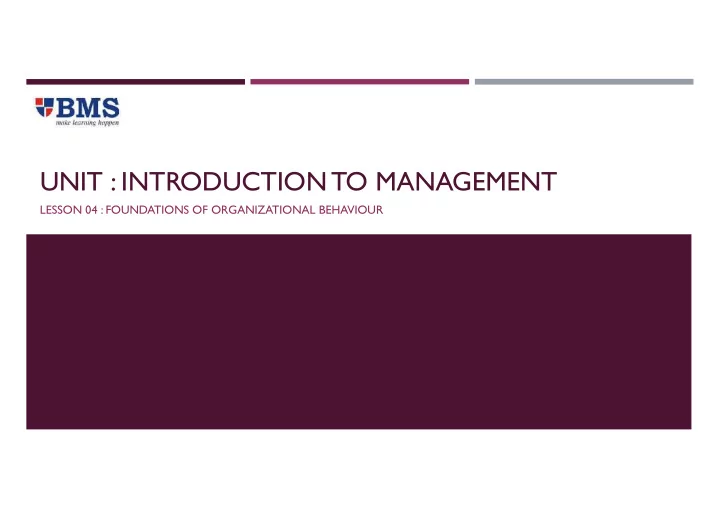

UNIT : INTRODUCTION TO MANAGEMENT LESSON 04 : FOUNDATIONS OF ORGANIZATIONAL BEHAVIOUR
ORGANIZATIONAL BEHAVIOR & IT’S IMPORTANCE Key Terminology : The study of the actions of people at work. Key Terminology : Leadership is the ability to influence people to achieve organizational goals. So, why OB important & what it has to do with “leading”? Visible aspect – Easily identifiable : Policies/Procedures/ Formal Authority relationships. Invisible aspect – NOT Easily identifiable: Informal relationships / Intergroup conflicts / Perceptions / Different attitudes.
INTRODUCTION TO LEADERSHIP Why is leadership is at the center of the organizational success ? Leader’s attitude & behavior play a key role in shaping employee’s attitudes which will influence their job satisfaction & organizational commitment
LEADERSHIP TRAITS Key Terminology : Traits : Distinguishing personal characteristics of person that makes him a leader. Can we really identify what traits “makes” a leader? However it is seen that certain “traits” will definitely increase the likelihood of being an effective leader. Key traits of a leader - Energy levels & stress tolerance. - Emotional stability & maturity. - Self confidence. - Personal integrity. - Achievement orientation * Refer Pg No: 69 to 71
MANAGEMENT VS LEADERSHIP Can a person be a leader without being a manager? Can a person be a manager without being a leader? Key Difference Manager Leader Promotes stability & order through out the company. Promotes Vision / creativity & change. - Suppliers are paid on time. - Challenges the status-quo. - Customers are invoiced properly. - Challenge unproductive norms. - On time accurate production. * Refer Pg No: 67
LEADERSHIP STYLES Key Terminology : The behavior of a leader in the attempt of handling his/her subordinates. Types of leadership styles Autocratic / Authoritarian Style Democratic Style Laissez-faire/ Free-rein style Refer Pg No : 73 to 76
AUTOCRATIC / AUTHORITARIAN STYLE Key Features - Centralize authority / dictates what needs to be done / makes his own decisions & limit subordinates. - They stay in charge always! & DIRECT employees. - Evaluations are done based on SUBJECTIVE praise & criticism not objective ( No constructive feedback). Strengths Weaknesses - Efficient & productive. - Hinders growth & creativity in the subordinates. - Provides clarity & direction. - Can create discontent aggressive team. - Establishes work standards easily. - Overtime subordinates will loose interest & become dissatisfied. - Accomplishes more in a lesser time period. - Loss of individuality.
DEMOCRATIC STYLE Key Features - Involve subordinates in decision making. - Used feedback as a method to coach employees. - See subordinates as fully capable of handling their jobs. - See themselves as “GUIDES NOT DIRECTORS”. Strengths Weaknesses - Greater creativity. - Demands more commitment from the leader. - Strong worker motivation. - Efficiency may get hindered. - Subordinates willing to participate. - More time consuming. - Friendliness : Mutual praise within the team. - Greater team satisfaction.
LAISSEZ-FAIRE/ FREE-REIN STYLE Key Features - Allows COMPLETE freedom for the subordinates to make decisions in the way they see fit. - Do not try to exert control. - Ignore workers & their motivations. - Some have labeled this style as “Non – leadership” - In essence “ Hands off style” / “Let it ride” attitude. Weaknesses Strengths - Limited task achievement. - May become successful where subordinates prefer complete freedom. - Subordinates are directionless. - Allows the experts to function by themselves while taking responsibility - Reduce productivity. & accountability. - Subordinates may become frustrated - Retains & motivates experts in a creative environment. & confused.
ORGANIZATIONAL CULTURE & LEADERSHIP Key terminology : Collection of traditions , values, policies, beliefs & attitudes that creates a persistent background for everything that the people do & think in an organization. Why is it important? Specially in the context of “Leadership”? The aspects that will distinguish the culture of a company Types of culture - The basic underlying assumptions. - Power Culture. - Over beliefs. - Role Culture. - Visible artifacts. - Task Culture. - Symbols. - Person Culture. - Rules/Norms/Ethics & Values. - Rituals & Celebrations. Refer Pg No : 79 & 80
MOTIVATION & THEORIES OF MOTIVATION Key terminology : The process by which a person’s efforts are energized, directed & sustained towards attaining a goal. Theories of Motivation Herzberg’s Two- factor Theory Maslow’s Hierarchy of Needs Theory Refer Pg No : 83 to 85
Q&A & REVISION
Recommend
More recommend